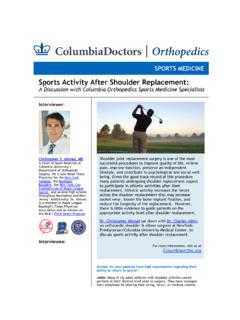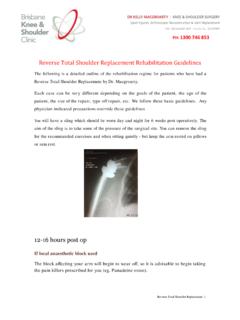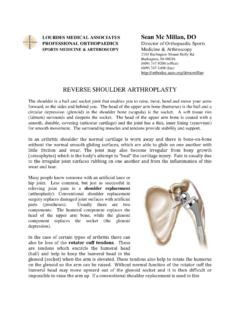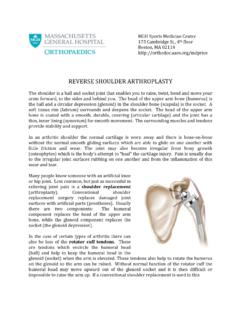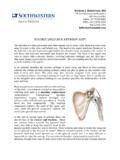Transcription of Reverse Total Shoulder Arthroplasty
1 Reverse Total Shoulder Arthroplasty Robert Rolf MD and Tim Elser PT, DHSc, ATC, OCS Indications Reverse Total Shoulder replacement is indicated for use in grossly rotator cuff deficient jointswith severe arthropathy, or for use when a previous joint replacement has failed with agrossly rotator cuff deficient joint. A functional Deltoid muscle is needed for use of this device. Also, the patient s joint must be anatomically and structurally suited to receive the device. The metaglene component and all other HA coated components are for cementless use only. All other components are intended for cemented use The following are contraindications for Shoulder Arthroplasty : Active local or systemic infection; Poor bone quality and/or inadequate bone stock to appropriately support the prosthesis; Severe deformity; Muscle, nerve or vascular disease; Obesity, drug abuse, over activity or mental and Precautions The following conditions tend to adversely affect the fixation of the Shoulder replacementimplants: Marked osteoporosis or poor bone stock, Metabolic disorders or systemic pharmacological treatments leading to progressivedeterioration of solid bone support for the implant ( , diabetes mellitus, steroid therapies,immunosuppressive therapies, etc.)
2 , History of general or local infections, Severe deformities leading to impaired fixation or improper positioning of the implant; Tumors of the supporting bone structures; Allergic reactions to implant materials ( bone cement, metal, polyethylene); Tissue reactions to implant corrosion or implant wear debris; Disabilities of other Effects The following are the most frequent adverse events encountered after Total or hemi-shoulderarthroplasty: Change in position of the prosthesis, often related to factors listed in Warnings andPrecautions. Early or late infection; Early or late loosening of the prosthetic component(s), often related to factors listed inWarnings and Precautions; Temporary inferior subluxation. Condition generally disappears as muscle tone is regained; Cardiovascular disorders including venous thrombosis, pulmonary embolism and myocardialinfarction; Hematoma and/or delayed wound healing; Pneumonia and/or atelectasis; Subluxation or dislocation of the replaced Total Shoulder Arthroplasty Protocol-Dr.
3 Rolf Hospital 2-3 days IP OTADL instructions Precautions Elbow, wrist and hand ROM No Shoulder ROM No IP PTDislocation Precautions Patients following a rTSA do not dislocate with the arm in abduction and external will typically dislocate with the arm in internal rotation and adduction in conjunctionwith extension. For example, tucking in a shirt or performing bathroom / personnel hygiene with theoperative arm is a dangerous activity particularly in the immediate peri-operative phase. No reaching across body to wash under opposite axilla or wash opposite Shoulder (6 weeks) Precautions should be implemented for the first 12 weeks postoperatively unless surgeonspecifically advises patient or therapist differently No Shoulder motion behind lower back and hip (no combined Shoulder adduction, internalrotation and extension)No reaching behind back (12 weeks) to: Tuck in shirt To pull belt through the back loops Reach to back pocket to get wallet out Fasten bra (if applicable) Perform personal hygiene No glenohumeral joint extension beyond neutral( always need to be able to see the elbow)(12 weeks) Progression to the next phase based on clinical criteria and time frames as appropriate Patient Precautions Avoid all activities using operative upper extremity for first 4 weeks except for those donewith the physical therapist.
4 Clothing: Oversized button down shirts, women should avoid wearing bras for the first 4wks No Shoulder AROM or passive range of motion (PROM). No lifting of objects with operative extremity. No supporting of body weight with involved extremity. Keep incision clean and dry (no soaking/wetting for 2 weeks); No whirlpool, Jacuzzi,ocean/lake wading for 4 long does the patient need to wear the sling? What position Shoulder the arm be placed in when wearing the sling? Normal rTSR Day 5-6 weeks Night 6 weeks Revision rTSR Day 5-6 weeks Night 6 weeks If lat dorsi tendon transfer (LDTT), place in gunslinger sling in neutral to 15 degrees ER position Outpatient PT-Begins 1 week post-op See MD protocol and MD guidelines for specific detailsWhen can patient begin codmans? 1 week post-op begin codman s forward/back Avoid adduction past midline and avoid IR DO NOT DO Codman side to side or CW, CCW If Shoulder is unstable per MD, do codman s on ball Can begin codman s side to side and CW/CCW at 3 weeks post-opStandard Post-op exercises Neck ROM Elbow, wrist, forearm hand AAROM Shoulder Shrugs Scapular RetractionWhen can patient begin PROM?
5 Any motions to avoid or limitations with motions? Begin flexion and scaption day 1-2 (limit flexion/scaption to 90 for 6 weeks) Begin PROM ER in POS to what MD got at operative findings Avoid PROM IR for 6 weeks At 6 weeks, begin IR in POS but do not exceed 50 degrees At 8 weeks-IR at 45 degrees Shoulder abduction At 10 weeks-IR at 60 degrees Shoulder abduction At 12 weeks-IR at 90 degrees Shoulder abductionWhat PROM for flexion/Scaption was MD able to obtain at time of surgery? This is the ultimate goal of rehab Do not push flexion/scaption beyond what MD got at time of surgery PROM flexion/scaption to 90 only for 6 weeks PROM ER 20-30 degrees in POS Can we move PROM beyond if no tissue resistance prior to 6weeks-NoHow far was Shoulder able to be passively ER in POS in operative findings before tension? MD will let us know this Do not move arm beyond these limits for the first 6 weeks in the POS At 6 weeks, begin PROM ER at 45-60 degrees abduction At 8 weeks, begin PROM ER at 90 degrees abductionWhen can patient begin Shoulder Isometrics for Deltoid ( Shoulder flexion/abduction/extension)?
6 Begin submaximal pain-free deltoid isometrics at 3 weeks PO as long as deltoid wasn tresected and repaired back down Shoulder flexion/abduction/extension) in scapular plane avoid Shoulder extension when isometric Shoulder extension for posterior deltoid. Do not do any resisted Shoulder adduction/IR or ERWhen can patient begin AAROM with pulley, cane-flexion, ER in POS? Can begin AAROM for motion at 6 weeks post-op? Can begin AAROM for motion at 8 weeks post-op for lat dorsi transferWhen can patient begin AROM? 6 weeks post-opWhen can patient begin Shoulder isotonic strengthening for Shoulder occur with band or small dumbbell? 12 weeks for all patientsWas the rTSR a revision? If so, delay the typical rTSR protocol by 3-4 weeks Patient will generally begin OP PT at 3-4 weeks post-op Begin PROM at 3-4 weeks post-op Begin AROM at 6 weeks post-op Begin strengthening at 8-12 weeks post-op Wear the sling for 4-6 weeks during the day Wear the sling 6 Weeks at nightWas there poor bone stock?
7 If so, delay the typical rTSR by 6 weeks Patient will generally begin OP PT at 6weeks post-op Begin PROM at 6 weeks post-op and progress ROM as tolerated Begin AROM at 8 weeks post-op Begin strengthening at 12 weeks post-op Wear the sling for 6 weeks during the day Wear the sling 6 weeks at nightWhat was the quality of the repaired soft tissue poor? Poor soft tissue quality occurs if there has been a prior open rotator cuff repair or if thedeltoid was retracted off the acromion If so, delay the typical rTSR by 3-4 weeks Begin PROM at 3-4 weeks post-op Begin AROM at 8 weeks post-op Begin strengthening at 12 weeks post-op Wear the sling for 4-6 weeks during the day Wear the sling 6 weeks at nightDid MD use deltopectoral incision or superior lateral approach? Deltopectoral incision See rTSA protocol-Dr. RolfSuperior lateral Dr. Rolf doesn t use this approach Deltoid surgically reflected off acromion Begin Shoulder deltoid isometrics at 6-8 weeks po Begin Shoulder deltoid isotonics at 8-12 weeks po Deltoid incised along its fibers Begin Shoulder deltoid isometrics at 3 weeks po Begin Shoulder deltoid isotonics at 6-8 weeks poWas subscapularis incised or reflected?
8 Only passive ER in POS as indicated by the operative findings for weeks 1-6 (this is usuallyaround 20-30 degrees) At 6-8 weeks can begin ER at 45-60 degrees abduction respecting the healing soft tissue At 8-12 weeks, can begin ER at 90 degrees abduction If the subscapularis was repairable, no active subscapularis (IR for 6 weeks) If the subscapularis was repairable, no resisted subscapularis (IR for 8 weeks)Was the rotator cuff deficient or absent? If deficient or absent, what part was absent (subscapularis, Supraspinatus, teres minor) Was the latissimus transferred for the function of the deficient ER s-If so, see rTSA LatDorsi Transfer protocol If posterior cuff repair-no passive IR If anterior (subscapularis) cuff repair-no passive ER beyond limits of operative findingsWas the latissimus dorsi used as a transfer for the ER s? If surgery is a revision or if poor bone stock is present, delay the normal protocol for 3-4weeks Avoid combined movement of Shoulder Adduction/IR and extension by reaching behind theback (prosthesis dislocation) for 12 weeks Avoid aggressive IR, Flexion (Lat Dorsi) and Adduction (prosthesis dislocation) for 6-8weeks May need biofeedback or neuromuscular re-education to retrain the latissimus dorsi to workas a humeral stabilizer for ERReverse Total Shoulder Arthroplasty Protocol-Dr.
9 Rolf Phase I: Immediate Postsurgical Phase, Joint Protection (Day 1 to Week 6) Goals: Promote healing of soft tissue/maintain the integrity of replaced joint Enhance PROM Restore active range of motion (AROM) of elbow/wrist/hand Independent with activities of daily living (ADL s) with modifications Patient and family independent with:Joint Protection Passive range of motion (PROM) Assisting with putting on/taking off sling and clothing Assisting with home exercise program (HEP) Precautions: Sling is worn for a 3-4 week postoperatively. The use of a sling may be extended for a totalof 6 weeks, often if it is a revision surgery While lying supine, the distal humerus/elbow should be supported by a pillow or towel roll toavoid Shoulder extension. Patient should always be able to visualize their elbow while lyingsupine When doing scapular PNF-make sure arm stays in neutral GH rotation and do not allow itadduct or IR No Shoulder AROM until 6 weeks post-op No lifting of objects with operative extremity No supporting of body weight with involved extremity Keep incision clean and dry for at least 2 weeksDay 1 to 4 (acute care PT) Begin PROM in supine after complete resolution of interscalene block (usually 24 to 48 hrspost-op) Forward flexion and elevation in the scapular plane in supine to 90 degrees External rotation (ER) in scapular plane to available ROM as indicated by operative findings,typically around 20-30 degrees No IR range of motion secondary to possibility of dislocation Codman s side to side only (avoid adduction and IR)
10 AAROM elbow/forearm/wrist/hand and neck Begin periscapular submaximal pain-free isometrics in the scapular plane Frequent ice application 15-20 minutes for at least 4-5 X per dayDays 5 to 21 Continue all previous exercises Begin submaximal pain-free deltoid isometrics at 3 weeks post-op Shoulder flexion/abduction/extension) in scapular plane(avoid Shoulder extension whenisometric Shoulder extension for posterior deltoid). Do not do any resisted Shoulder adduction/IR or ER Frequent ice application 15-20 minutes for at least 4-5 X per dayWeeks 3 to Week 6 Progress previous exercises Progress PROM Forward flexion and elevation in the scapular plane in supine to 120 degrees ER in scapular plane to tolerance, respecting soft tissue constraints At 6 weeks post-operatively start PROM IR to tolerance (not to exceed 50 degrees) in thescapular plane Gentle resisted exercise of elbow, wrist, and hand Continue frequent cryotherapyCriteria for Progression to the Next Phase (Phase II) Patient tolerates Shoulder PROM and AROM program for elbow, wrist and hand Patient demonstrates the ability to isometrically activate all components of the deltoid andperiscapular musculature in the scapular planePhase II-AROM, Early Strengthening Phase (Weeks 6 to 12) Goals.




